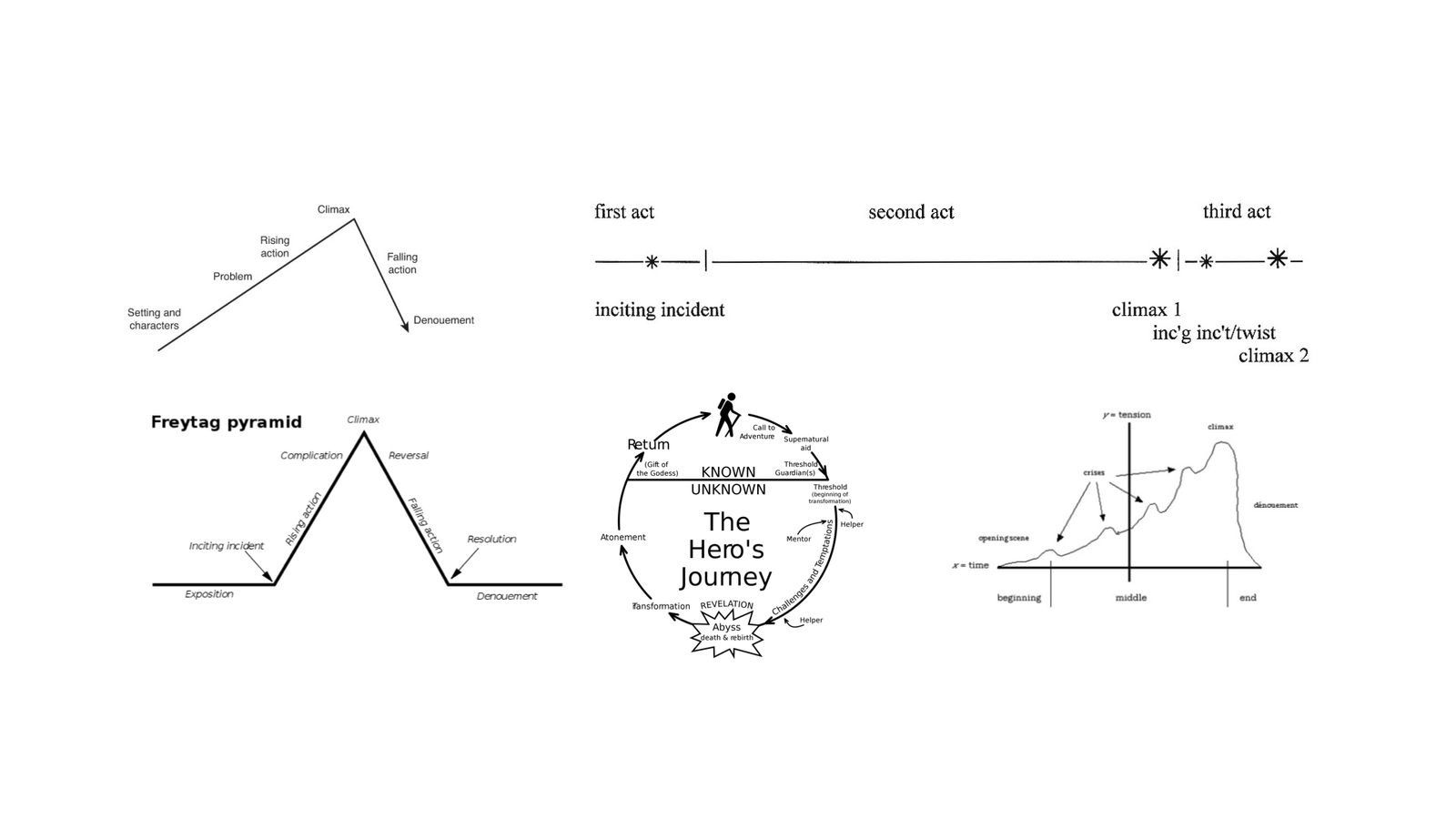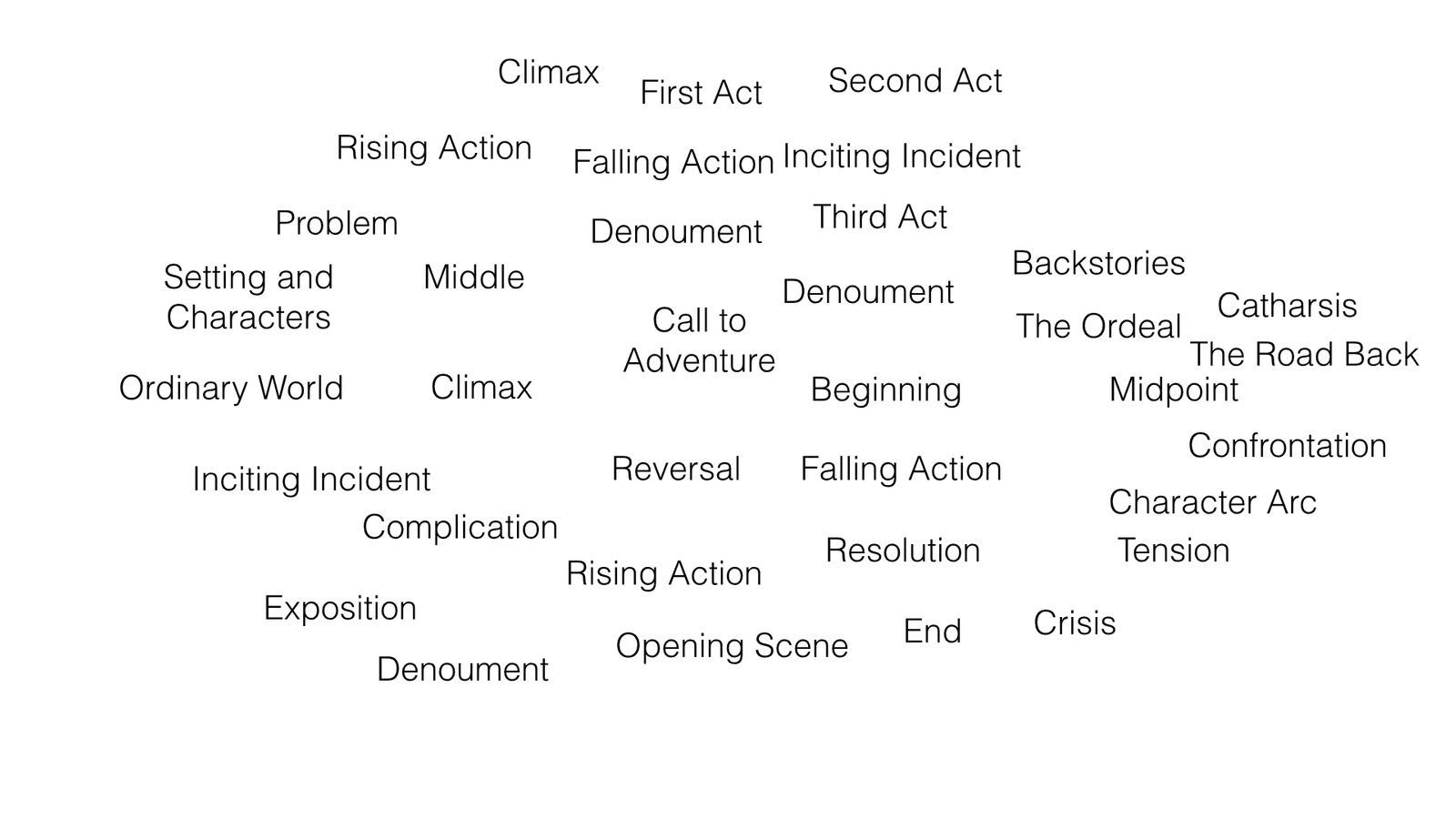Lesson: WOARO and Story
Video and Audio Versions
There are two sides to screenwriting: formatting and storytelling. In this class, we'll practice both—with an emphasis on story in the lessons.
What is WOARO and why do I use it?
When it comes to story, there are lots of story approaches with lots of different terminologies.


Story Approaches and Terminology
And there are plenty of guides out there to help writers, suggesting multiple plot points that you must hit on specific pages.

But I find all of this overcomplicating the idea of storytelling and plot—or making it too formulaic.
That was when I discovered Jerry Cleaver's Immediate Fiction, which broke the story into a simple formula:
Conflict + Action + Resolution = Story

I developed this a bit through practice and further study to end up with WOARO.
( Want/ Obstacle) + ( Action/ Response) + Outcome = Story
To put it into story form:
A character wants something, but an obstacle stands in her way. Therefore, she takes action, which gets a response, creating conflict. She will continue taking new actions, facing new responses, until she comes to an outcome that is either positive or negative.
Reasons I like WOARO:
- It offers a balance between plot and character.
- It creates a self-contained piece of the action.
- It reflects all human actions. We all have wants, take actions, and get responses, and all of these things define the character of who we are.
- Finally, it can grow and be reshaped to fit a 2-3 page scene, all the way up to a TV series or multi-film story arc.

A breakdown of the pieces
Want
These are the goals that drive your characters, and two types occur in a story:
- External: These wants operate within the boundaries of the story and push it forward. It is often what the audience expects from your story: get the treasure, find the killer, get the romantic love interest. They are external and specific and push your character to take action and propel the story forward.
- Internal: The other operates outside the boundaries of your story. These are the big character goals that drive us through life. They could be happiness, love, wealth, power, or status. They are internal and abstract and not defined by a concrete value. They rarely change.
We must have a want that is dramatic. To emotionally engage an audience we have to have the sense that the protagonist can’t imagine a world without it. The character must feel that satisfying their want is a matter of life or death.
Lastly, want is the flag you as a writer set in the ground to signal the end.
Obstacle
The want can’t exist in a vacuum. There is always something in conflict with want.
Obstacles can be other people with their own wants, actions, and responses. They can also be inner desires, drives, or ghosts that haunt a character’s past.
The resolution of an obstacle leads to an outcome.
Good writers (and directors) help orientate their audience by utilizing these principles.
Action
Actions are what a character does or says to get what they want. These are the moment-by-moment actions and dialogue that you show on the page.
Whatever a character does in your story has an intention to get or do something. Something is always driving them forward.
Actions are active and often being done to someone or something else. For example, Tom hits Bill, Sally kisses Greg, or Bob breaks the wall.
With scriptwriting, we must place these actions on the page. They must be external.
Response
Actions need a response. Responses are the consequence of the hero or villain taking an action. There are two levels of responses:
- An external response, like fighting, yelling, running away.
- An internal response, like emotions or internal thoughts.
When writing for the screen, we focus on showing external responses. Internal responses are the focus of the director and actor.
‼️ The wants, actions, and responses of a character define them.
Outcome
This occurs when the want is either achieved or isn't (win or lose) at the end of the story.
It happens when our characters reach the limits of their resources and abilities when no further responses and no further actions can be taken.
Remember that wanting never ends.
Whatever the outcome is, it must be shown on the page.
When Working with WOARO, ask these questions:
- Who wants what?
- Where is the want on the page? Can it be stronger? Can it appear earlier?
- Where is the obstacle? Where does it appear? Can it be earlier? Can it be stronger? Can it not be ignored?
- What’s the action? Where is it? Can it appear earlier? Can they be more assertive or direct against the obstacle and towards the want?
- What's the character's response?
- What is the outcome? Does the character get what they want?
WOARO as Story
- W/O + A/R + O defines the shape and beats of all scenes, sequences, acts, and scripts.
- Each screenplay act (e.g. Act 1) is the fulfillment of a character’s action
- Action and Response are the heart of the visual story. SHOW IT!

Should you always use WOARO?
No. You need to understand it, but you only need to use WOARO when you know the story isn't working.
Is WOARO the only way to go?
No, there are plenty of different approaches—however, most of them follow the same model. WOARO creates engagement with the audience and is pretty much universal in Western storytelling.
There are other forms, ones that push for anti-plot, no plot, or non-causality. However, for this class, we'll focus on the fundamentals of the traditional story.
Please notice that I did leave the door open for other things like open-endings and non-linear time—but if you go with them, I may ask you why you made these choices.
Reminders:
- The rules that apply to large structures can be applied to small structures.
- WOARO and 3-act structure are not about using a formula but about finding your story’s form—finding its shape.
- Use it to create complex, fresh stories.
- WOARO = Story = Life
Assignment
Show me your basic storytelling skills.
Write a 2-3 page scene that shows a character with an external want facing an external obstacle. The character must take an action that leads to a response from the obstacle. This must culminate in an outcome.
Marking Criteria:
- Proper screenplay format (including active, present tense; sluglines; parentheticals; and ALL CAPS on character introductions).
- Proper spelling, punctuation, and grammar.
- We as readers must be able to identify the external want and external obstacle, either visually or through dialogue—meaning, make sure it’s on the page.
- Stay on the page count of the assignment.
- 5 mistakes are allowed per script.
Regarding Feedback:
- Keep an eye open for the criteria. If you notice errors, help your fellow writers.
- Again, think reciprocity. Offer advice that you’d hope others would give you.
- Refer to the Advice on Feedback page.
Due: Sunday, September 10 at midnight ( Saskatchewan time ).